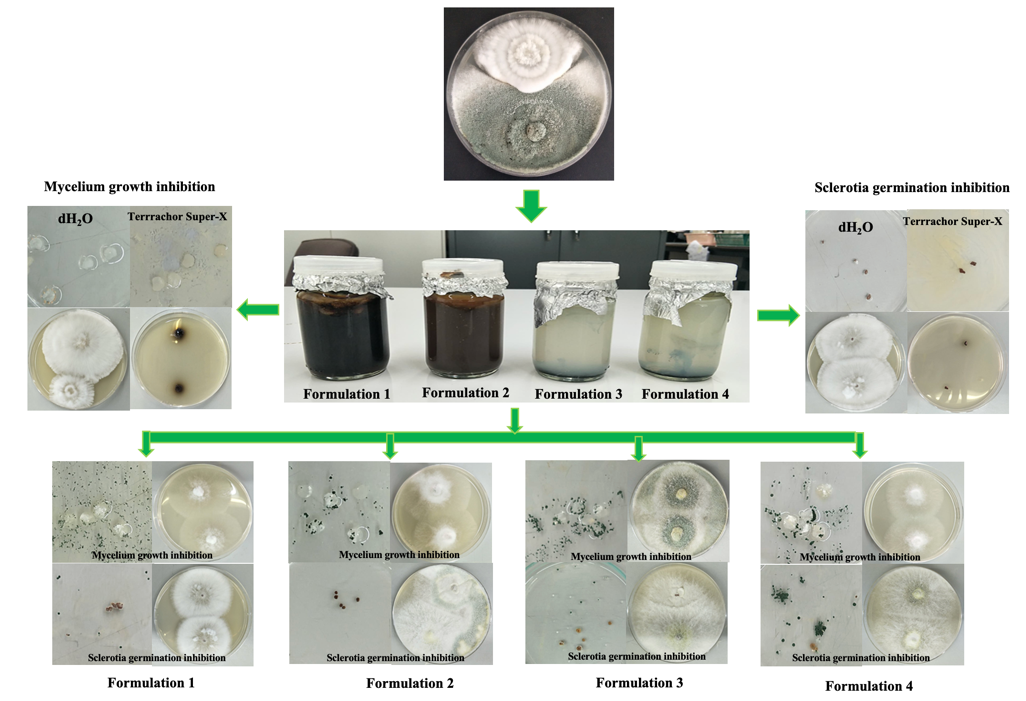Enhancing Biocontrol Potential: Development and Efficacy Assessment of a Liquid Formulation of Trichoderma Asperellum MSU007 against Sclerotium Rrolfsii
DOI:
https://doi.org/10.48048/tis.2024.7550Keywords:
Biocontrol, Trichoderma asperellum MSU007, Liquid formulation, Protectants, Sclerotium wilt, Sustainable agricultureAbstract
Global agricultural systems face significant challenges due to the devastating impact of Sclerotium rolfsii, a plant pathogen responsible for substantial crop yield losses. Considering this problem, this study aims to enhance biocontrol potential against S. rolfsii by developing and evaluating a liquid formulation of Trichoderma asperellum MSU007. We prepared 4 distinct liquid formulations of T. asperellum MSU007, incorporating various protectants: 10 % molasses, 5 % molasses, 5 % lactose and 5 % trehalose. After 45 days at 28 ± 2 °C, T. asperellum MSU007 spore counts remained consistent at 107 spores/mL across all formulations. All formulations resulted in no growth and effectively suppressed S. rolfsii mycelium growth at concentration of 4, 5 and 6 mL/L. Transferring inhibited mycelium to fresh Potato Dextrose Agar (PDA) showed growth resembling T. asperellum MSU007 within 48 h. Terrachor Super-X fungicide fully suppressed growth. Notably, the 5 % trehalose formulation continued inhibiting sclerotia germination even after 45-day storage. This study highlights T. asperellum MSU007 formulations, particularly those based on trehalose as promising agents for disease control and prolonged storage stability. Future mechanistic investigations will be crucial to comprehensive understanding and application.
HIGHLIGHTS
Liquid formulations of Trichoderma asperellum MSU007 with different protectants were developed for enhanced biocontrol against Sclerotium rolfsii. All formulations effectively suppressed S. rolfsii mycelium growth at various application rates. The 5 % trehalose-based formulation displayed prolonged inhibition of sclerotia germination even after 45-day storage. These findings suggest the potential of T. asperellum MSU007 formulations, particularly trehalose-based, for disease control and extended storage stability, warranting further mechanistic investigation.
GRAPHICAL ABSTRACT

Downloads
Metrics
References
GE Harman, CR Howell, A Viterbo, I Chet and M Lorito. Trichoderma species-opportunistic, avirulent plant symbionts. Nat. Rev. Microbiol. 2004; 2, 43-56.
R Tyśkiewicz, A Nowak, E Ozimek and J Jaroszuk-Ściseł. Trichoderma: The current status of its application in agriculture for the biocontrol of fungal phytopathogens and stimulation of plant growth. Int. J. Mol. Sci. 2022; 23, 2329.
L Selbmann, S Onofri, M Fenice, F Federici and M Petruccioli. Production and structural characterization of the exopolysaccharide of the Antarctic fungus Phoma herbarum CCFEE 5080. Res in Microbiol. 2002; 153, 585-92.
B Huang, H Jia, X Han, J Gou, C Huang, J Wang, J Wei, J Wang and C Zhang. Effects of biocontrol Bacillus and fermentation bacteria additions on the microbial community, functions and antibiotic resistance genes of prickly ash seed oil meal-biochar compost. Bioresour. Tech. 2021; 340, 125668.
M Khan, M Salman, SA Jan and ZK Shinwari. Biological control of fungal phytopathogens: A comprehensive review based on Bacillus species. MOJ. Biol. Med. 2021; 6, 90-2.
AK Mukherjee, AS Kumar, S Kranthi and PK Mukherjee. Biocontrol potential of three novel Trichoderma strains: isolation, evaluation and formulation. 3 Biotech 2014; 4, 275-81.
A Sharma, PL Kashyap, AK Srivastava, YK Bansal and R Kaushik. Isolation and characterization of halotolerant bacilli from chickpea (Cicer arietinum L.) rhizosphere for plant growth promotion and biocontrol traits. Eur. J. Plant Pathol. 2019; 153, 787-800.
LV Kolombet, SK Zhigletsova, NI Kosareva, EV Bystrova, VV Derbyshev, SP Krasnova and D Schisler. Development of an extended shelf-life, liquid formulation of the biofungicide Trichoderma asperellum. World J. Microbiol. Biotechnol. 2008; 24, 123-31.
G Oros and Z Naár. Mycofungicide: Trichoderma based preparation for foliar applications. American J. Plant Sci. 2017; 8, 113-25.
G Naveenkumar and R Sendilkumar. Item analysis methodology to measure knowledge of farmer’s on eco-friendly farm technology in rice cultivar. J. Krishi Vigyan 2015; 4, 56-9.
W Sutthisa, A Popranom, A Taddeetrakool and S Khankhum. Development of Trichoderma formulation and application to control durian anthracnose disease. Trends Sci. 2024; 21, 7276.
DAS Gebily, GAM Ghanem, MM Ragab, AA Ali, NEK Soliman and THA El-Moity. Characterization and potential antifungal activities of three Streptomyces spp. as biocontrol agents against Sclerotinia sclerotiorum (Lib.) de Bary infecting green bean. Egypt. J. Biol. Pest Contr. 2021; 31, 33.
W Sutthisa. Biological control properties of Cyathus spp. to control plant disease pathogens. J. Pure Appl. Microbiol. 2018; 12, 1755-60.
LG Silva, RC Camargo, GM Moura, PSO Nunes, C Dunlap and W Bettiol. Dual functionality of Trichoderma: biocontrol of Sclerotinia sclerotiorum and biostimulant of cotton plants. Front. Plant Sci. 2022; 13, 983127.
J Liu, SP Tian, BQ Li and QZ Qin. Enhancing viability of two biocontrol yeasts in liquid formulation by applying sugar protectant combined with antioxidant. BioControl. 2009; 54, 817-24.
J Yuan, Y Ruan, B Wang, J Zhang, R Waseem, Q Huang and Q Shen. Plant growth-promoting rhizobacteria strain Bacillus amyloliquefaciens NJN-6-enriched bio-organic fertilizer suppressed Fusarium wilt and promoted the growth of banana plants. J. Agric. Food Chem. 2013; 61, 3774-3780.
LC de Rezende, AL de Andrade Carvalho, LB Costa, B de Almeida Halfeld-Vieira, LG Silva, ZV Pinto, MAB Morandi, FHV de Medeiros, GM Mascarin and W Bettiol. Optimizing mass production of Trichoderma asperelloides by submerged liquid fermentation and its antagonism against Sclerotinia sclerotiorum. World J. Microbiol. Biotechnol. 2020; 36, 113.
MR Chowdhury, SF Ahmed, B Khalid, ZF Bony, JF Asha and MKA Bhuiyan. Biocontrol efficiency of microencapsulated Trichoderma harzianum coupled with organic additives against potato stem rot caused by Sclerotium rolfsii. Plant Stress 2023; 9, 100181.

Downloads
Published
How to Cite
Issue
Section
License
Copyright (c) 2023 Walailak University

This work is licensed under a Creative Commons Attribution-NonCommercial-NoDerivatives 4.0 International License.






